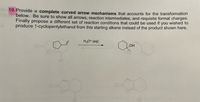
Chemistry
10th Edition
ISBN: 9781305957404
Author: Steven S. Zumdahl, Susan A. Zumdahl, Donald J. DeCoste
Publisher: Cengage Learning
expand_more
expand_more
format_list_bulleted
Concept explainers
Question

Transcribed Image Text:19. Provide a complete curved arrow mechanisms that accounts for the transformation
below. Be sure to show all arrows, reaction intermediates, and requisite formal charges.
Finally propose a different set of reaction conditions that could be used if you wished to
produce 1-cyclopentylethanol from this starting alkene instead of the product shown here.
H30+ (aq)
HO
Expert Solution
This question has been solved!
Explore an expertly crafted, step-by-step solution for a thorough understanding of key concepts.
This is a popular solution
Trending nowThis is a popular solution!
Step by stepSolved in 2 steps with 2 images

Knowledge Booster
Learn more about
Need a deep-dive on the concept behind this application? Look no further. Learn more about this topic, chemistry and related others by exploring similar questions and additional content below.Similar questions
- Propose a sequence of reactions that efficiently converts the given starting material(s) to the target molecule. Draw the structure of the product formed after each synthetic step. Do not write mechanisms. (All carbons must come from the starting materials given.)arrow_forwarda Use curved arrows to show how the alkene below will react with a proton. Make the ends of your arrows specify the origin and destination of reorganizing electrons. Arrow-pushing Instructions N ↔X ➤XT H*arrow_forwardCan you please explain when it comes to the order of placing the substituents? Thank you for your help.arrow_forward
- 6A1: Distinguish between synthetic and retrosynthetic transformations to solve problems and predict starting materials and products. Draw any retrosynthetic sequence where a hydroxyl cycloalkane retron can be retrosynthesized into an appropriate cycloalkene, where the cycloalkene can be retrosynthesized into an appropriate cycloalkane halide. While you are allowed to work out this problem synthetically, you MUST report your final response in the retrosynthetic direction using the symbology we learned in lecture/arrow_forwardFill in the major products to complete the transformations. Be sure to pay carefulattention to stereochemistry where appropriate. If the major product is a pair of enantiomers or diastereomers be sure to draw them both. And indicate whether you have drawn an enantiomer or a diastereomer. (Don't forget about rearrangement).arrow_forwardIdentify the reagents you would use to perform the following transformation: Bromocyclohexane →→ Cyclohexanecarboxylic acid The transformation above can be performed with some reagent or combination of the reagents listed below. Give the necessary reagents in the correct order, as a string of letters (without spaces or punctuation, such as "EBF"). If there is more than one correct solution, provide just one answer. A. H3O+, heat D. 1) CO2; 2) H3O+ B. Na₂Cr₂O7, H₂SO4, H₂O E. PCC or DMP C. NaCN F. Mgarrow_forward
- Draw the structure of the starting material needed to make 2-methylhept-3-yne using sodium amide in liquid ammonia, followed by 1-bromopropane. The starting hydrocarbon must have no more than five carbons 1) NaNH2, NH3() NaBr + 2) CHзCH2CH2Brarrow_forward3) Draw a stepwise mechanism for the treatment of the ester below with methyl Grignard followed by use curved arrows to indicate electron movement, show all intermediates and indicate all non-zero formal charges. FOCH, 1) CH,MgBr (excess), ether 2) H3O+ OHarrow_forwardYou attempt to synthesize ethyl isopropyl ether using the following scheme, but you find that you are getting a large amount of some minor product. Br NaOCH2CH3 HOCH,CH3 a) What is the side product you are forming and what would be a better way to synthesize ethyl isopropyl ether? b) What would be the major product of the following reaction? Br NaOCH,CH3 HOCH,CH3arrow_forward
arrow_back_ios
arrow_forward_ios
Recommended textbooks for you
 ChemistryChemistryISBN:9781305957404Author:Steven S. Zumdahl, Susan A. Zumdahl, Donald J. DeCostePublisher:Cengage Learning
ChemistryChemistryISBN:9781305957404Author:Steven S. Zumdahl, Susan A. Zumdahl, Donald J. DeCostePublisher:Cengage Learning ChemistryChemistryISBN:9781259911156Author:Raymond Chang Dr., Jason Overby ProfessorPublisher:McGraw-Hill Education
ChemistryChemistryISBN:9781259911156Author:Raymond Chang Dr., Jason Overby ProfessorPublisher:McGraw-Hill Education Principles of Instrumental AnalysisChemistryISBN:9781305577213Author:Douglas A. Skoog, F. James Holler, Stanley R. CrouchPublisher:Cengage Learning
Principles of Instrumental AnalysisChemistryISBN:9781305577213Author:Douglas A. Skoog, F. James Holler, Stanley R. CrouchPublisher:Cengage Learning Organic ChemistryChemistryISBN:9780078021558Author:Janice Gorzynski Smith Dr.Publisher:McGraw-Hill Education
Organic ChemistryChemistryISBN:9780078021558Author:Janice Gorzynski Smith Dr.Publisher:McGraw-Hill Education Chemistry: Principles and ReactionsChemistryISBN:9781305079373Author:William L. Masterton, Cecile N. HurleyPublisher:Cengage Learning
Chemistry: Principles and ReactionsChemistryISBN:9781305079373Author:William L. Masterton, Cecile N. HurleyPublisher:Cengage Learning Elementary Principles of Chemical Processes, Bind...ChemistryISBN:9781118431221Author:Richard M. Felder, Ronald W. Rousseau, Lisa G. BullardPublisher:WILEY
Elementary Principles of Chemical Processes, Bind...ChemistryISBN:9781118431221Author:Richard M. Felder, Ronald W. Rousseau, Lisa G. BullardPublisher:WILEY

Chemistry
Chemistry
ISBN:9781305957404
Author:Steven S. Zumdahl, Susan A. Zumdahl, Donald J. DeCoste
Publisher:Cengage Learning

Chemistry
Chemistry
ISBN:9781259911156
Author:Raymond Chang Dr., Jason Overby Professor
Publisher:McGraw-Hill Education

Principles of Instrumental Analysis
Chemistry
ISBN:9781305577213
Author:Douglas A. Skoog, F. James Holler, Stanley R. Crouch
Publisher:Cengage Learning

Organic Chemistry
Chemistry
ISBN:9780078021558
Author:Janice Gorzynski Smith Dr.
Publisher:McGraw-Hill Education

Chemistry: Principles and Reactions
Chemistry
ISBN:9781305079373
Author:William L. Masterton, Cecile N. Hurley
Publisher:Cengage Learning

Elementary Principles of Chemical Processes, Bind...
Chemistry
ISBN:9781118431221
Author:Richard M. Felder, Ronald W. Rousseau, Lisa G. Bullard
Publisher:WILEY